HA2032 Corporate and Financial Accounting Report: Company Analysis
VerifiedAdded on 2022/10/01
|15
|3565
|45
Report
AI Summary
This report presents a financial analysis of two Australian Stock Exchange (ASX)-listed companies in the energy sector: Whitehaven Coal Limited and Caltex Australia. The analysis focuses on their financial performance, particularly profitability, solvency, and the management of financing activities and investments. The report delves into the recording of items under owner's equity, including issued capital, treasury stock, reserves, and retained earnings, as well as the components of liabilities, both current and non-current. It compares the equity structures and liability profiles of both companies, highlighting the advantages and disadvantages of debt and equity financing. The report examines the sources of funds employed by each company, with Whitehaven Coal primarily using equity and Caltex Australia relying more on debt. The report also discusses the implications of these financial choices, including the impact on cash flow, credit ratings, and overall financial risk, providing a comprehensive overview of corporate and financial accounting practices and their strategic implications.
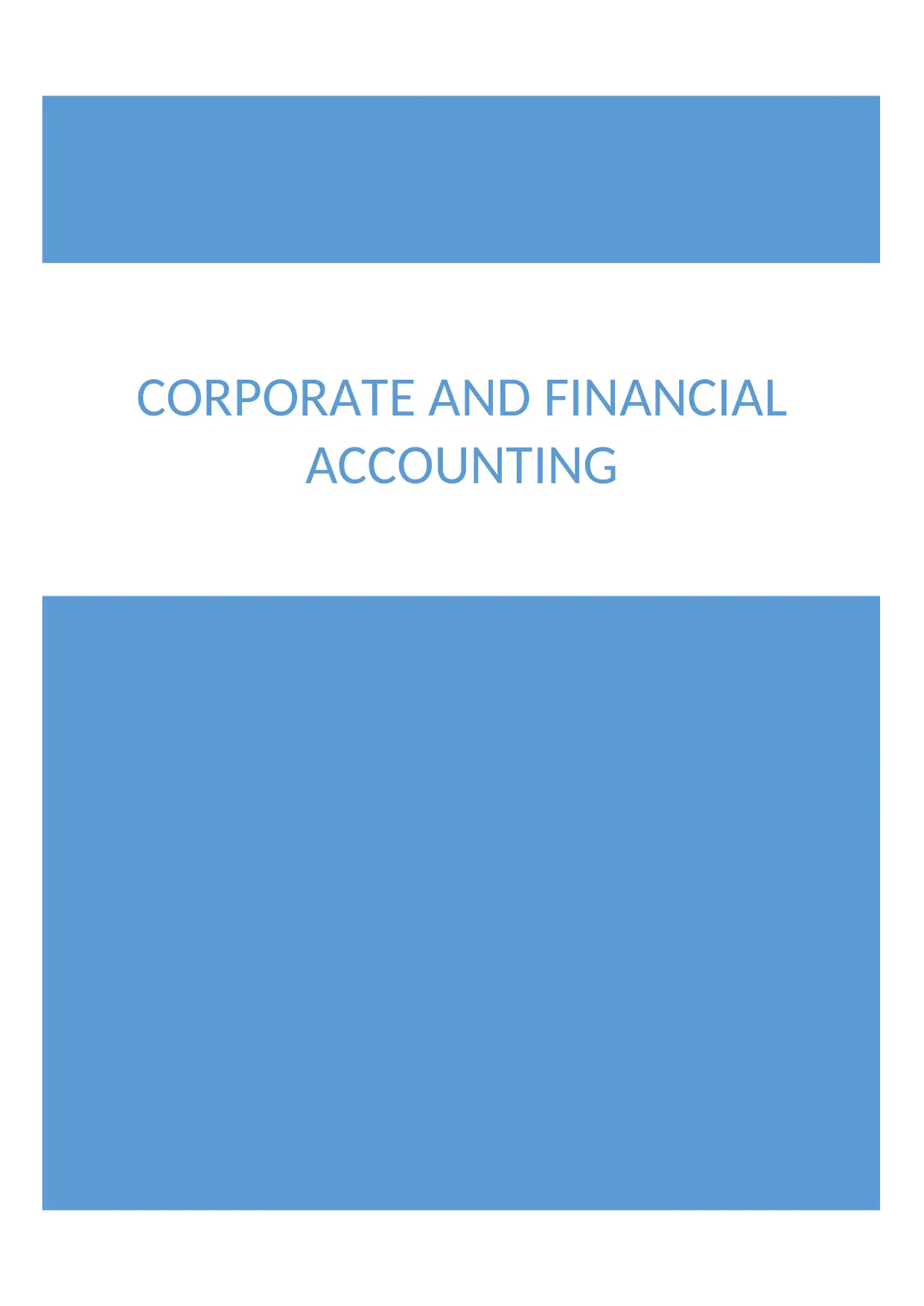
CORPORATE AND FINANCIAL
ACCOUNTING
ACCOUNTING
Paraphrase This Document
Need a fresh take? Get an instant paraphrase of this document with our AI Paraphraser
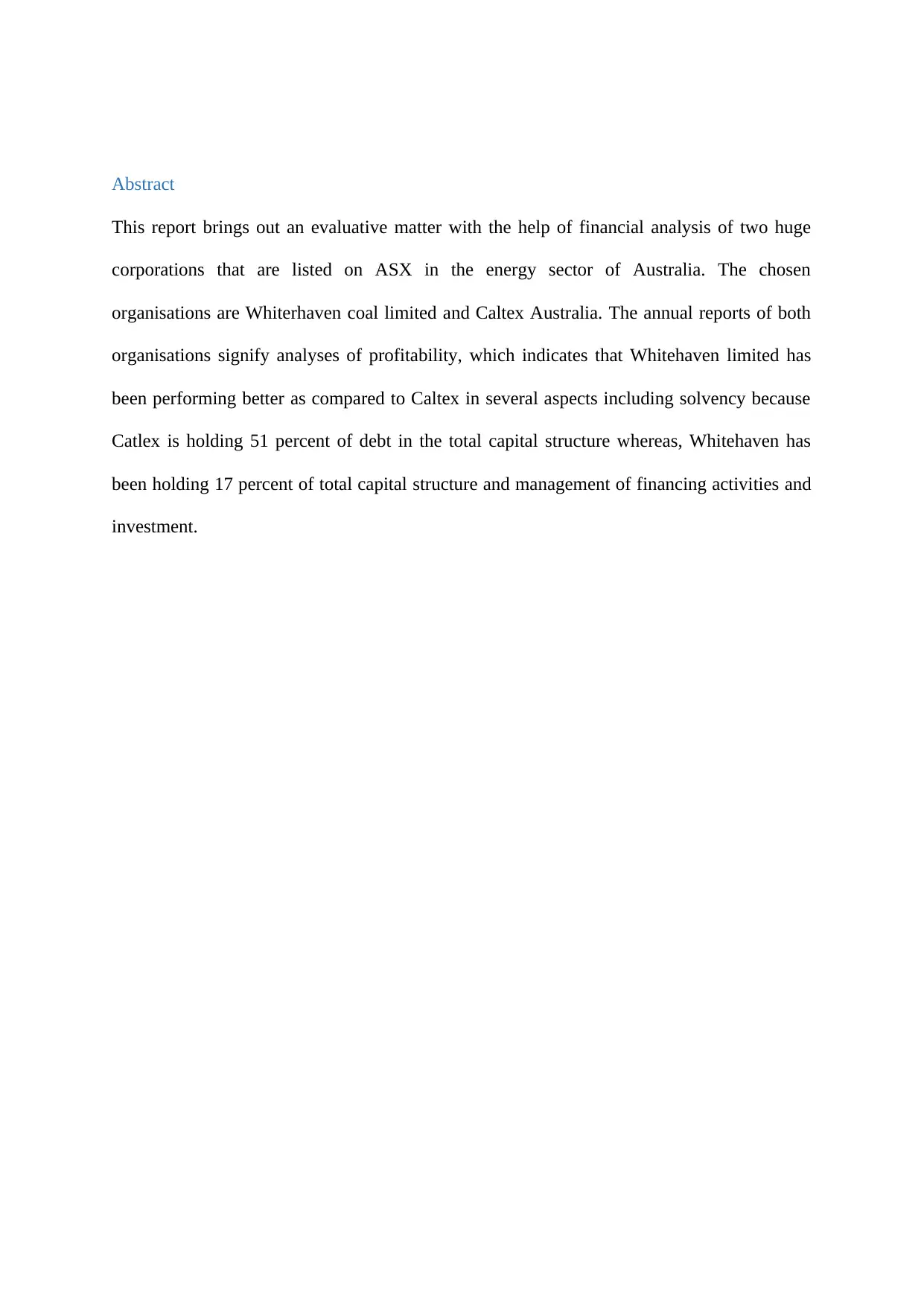
Abstract
This report brings out an evaluative matter with the help of financial analysis of two huge
corporations that are listed on ASX in the energy sector of Australia. The chosen
organisations are Whiterhaven coal limited and Caltex Australia. The annual reports of both
organisations signify analyses of profitability, which indicates that Whitehaven limited has
been performing better as compared to Caltex in several aspects including solvency because
Catlex is holding 51 percent of debt in the total capital structure whereas, Whitehaven has
been holding 17 percent of total capital structure and management of financing activities and
investment.
This report brings out an evaluative matter with the help of financial analysis of two huge
corporations that are listed on ASX in the energy sector of Australia. The chosen
organisations are Whiterhaven coal limited and Caltex Australia. The annual reports of both
organisations signify analyses of profitability, which indicates that Whitehaven limited has
been performing better as compared to Caltex in several aspects including solvency because
Catlex is holding 51 percent of debt in the total capital structure whereas, Whitehaven has
been holding 17 percent of total capital structure and management of financing activities and
investment.
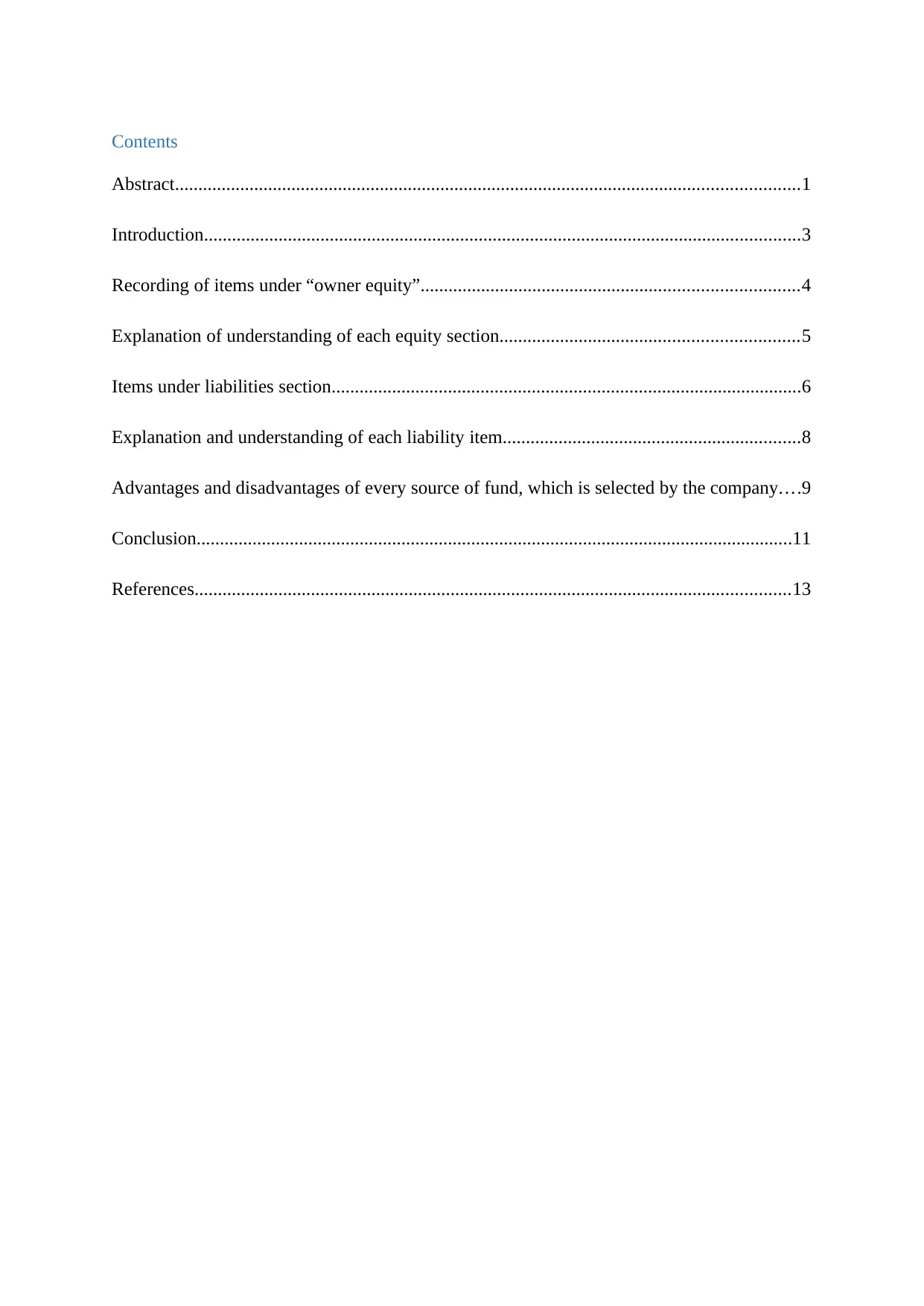
Contents
Abstract......................................................................................................................................1
Introduction................................................................................................................................3
Recording of items under “owner equity”.................................................................................4
Explanation of understanding of each equity section................................................................5
Items under liabilities section.....................................................................................................6
Explanation and understanding of each liability item................................................................8
Advantages and disadvantages of every source of fund, which is selected by the company....9
Conclusion................................................................................................................................11
References................................................................................................................................13
Abstract......................................................................................................................................1
Introduction................................................................................................................................3
Recording of items under “owner equity”.................................................................................4
Explanation of understanding of each equity section................................................................5
Items under liabilities section.....................................................................................................6
Explanation and understanding of each liability item................................................................8
Advantages and disadvantages of every source of fund, which is selected by the company....9
Conclusion................................................................................................................................11
References................................................................................................................................13
⊘ This is a preview!⊘
Do you want full access?
Subscribe today to unlock all pages.

Trusted by 1+ million students worldwide
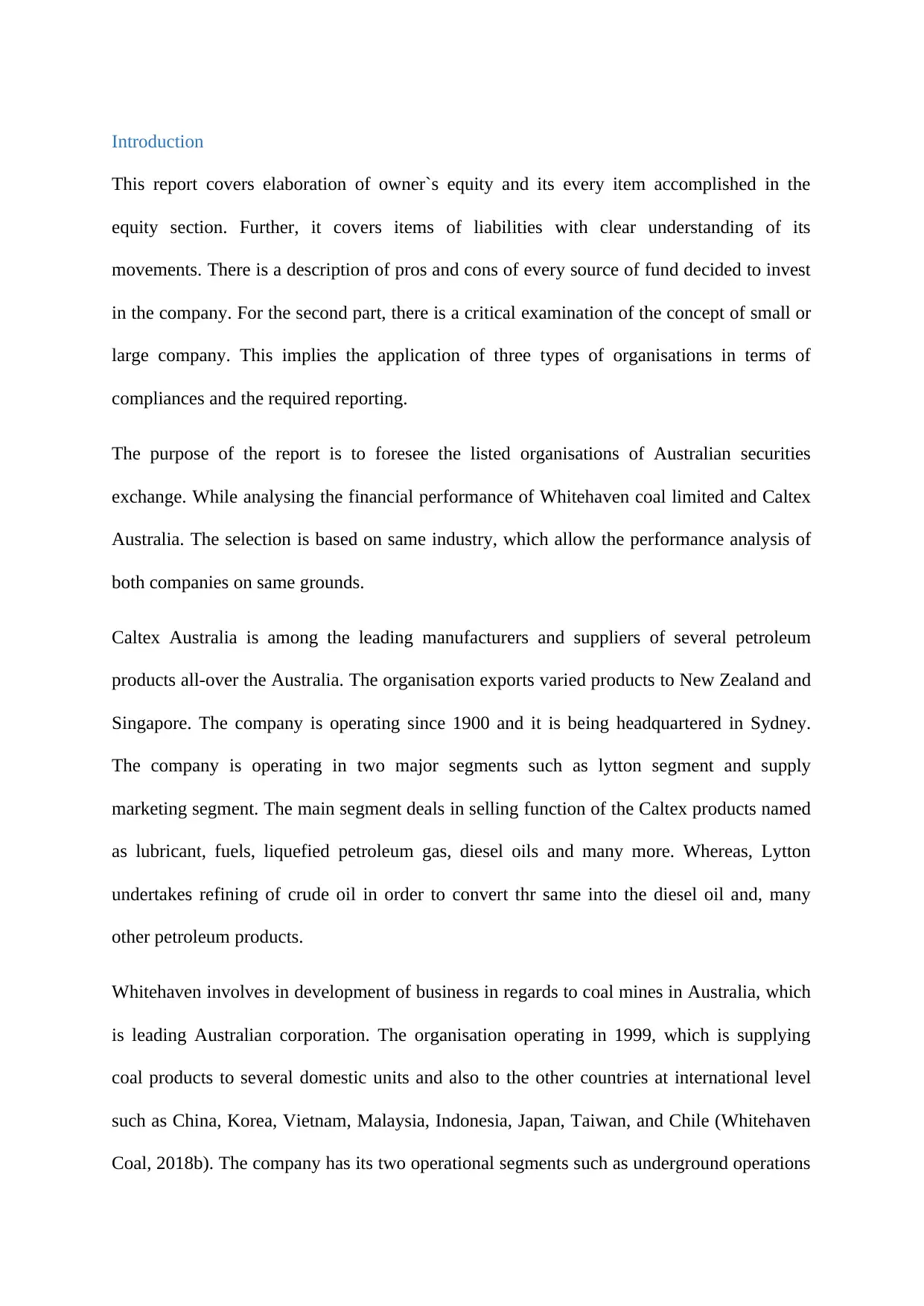
Introduction
This report covers elaboration of owner`s equity and its every item accomplished in the
equity section. Further, it covers items of liabilities with clear understanding of its
movements. There is a description of pros and cons of every source of fund decided to invest
in the company. For the second part, there is a critical examination of the concept of small or
large company. This implies the application of three types of organisations in terms of
compliances and the required reporting.
The purpose of the report is to foresee the listed organisations of Australian securities
exchange. While analysing the financial performance of Whitehaven coal limited and Caltex
Australia. The selection is based on same industry, which allow the performance analysis of
both companies on same grounds.
Caltex Australia is among the leading manufacturers and suppliers of several petroleum
products all-over the Australia. The organisation exports varied products to New Zealand and
Singapore. The company is operating since 1900 and it is being headquartered in Sydney.
The company is operating in two major segments such as lytton segment and supply
marketing segment. The main segment deals in selling function of the Caltex products named
as lubricant, fuels, liquefied petroleum gas, diesel oils and many more. Whereas, Lytton
undertakes refining of crude oil in order to convert thr same into the diesel oil and, many
other petroleum products.
Whitehaven involves in development of business in regards to coal mines in Australia, which
is leading Australian corporation. The organisation operating in 1999, which is supplying
coal products to several domestic units and also to the other countries at international level
such as China, Korea, Vietnam, Malaysia, Indonesia, Japan, Taiwan, and Chile (Whitehaven
Coal, 2018b). The company has its two operational segments such as underground operations
This report covers elaboration of owner`s equity and its every item accomplished in the
equity section. Further, it covers items of liabilities with clear understanding of its
movements. There is a description of pros and cons of every source of fund decided to invest
in the company. For the second part, there is a critical examination of the concept of small or
large company. This implies the application of three types of organisations in terms of
compliances and the required reporting.
The purpose of the report is to foresee the listed organisations of Australian securities
exchange. While analysing the financial performance of Whitehaven coal limited and Caltex
Australia. The selection is based on same industry, which allow the performance analysis of
both companies on same grounds.
Caltex Australia is among the leading manufacturers and suppliers of several petroleum
products all-over the Australia. The organisation exports varied products to New Zealand and
Singapore. The company is operating since 1900 and it is being headquartered in Sydney.
The company is operating in two major segments such as lytton segment and supply
marketing segment. The main segment deals in selling function of the Caltex products named
as lubricant, fuels, liquefied petroleum gas, diesel oils and many more. Whereas, Lytton
undertakes refining of crude oil in order to convert thr same into the diesel oil and, many
other petroleum products.
Whitehaven involves in development of business in regards to coal mines in Australia, which
is leading Australian corporation. The organisation operating in 1999, which is supplying
coal products to several domestic units and also to the other countries at international level
such as China, Korea, Vietnam, Malaysia, Indonesia, Japan, Taiwan, and Chile (Whitehaven
Coal, 2018b). The company has its two operational segments such as underground operations
Paraphrase This Document
Need a fresh take? Get an instant paraphrase of this document with our AI Paraphraser
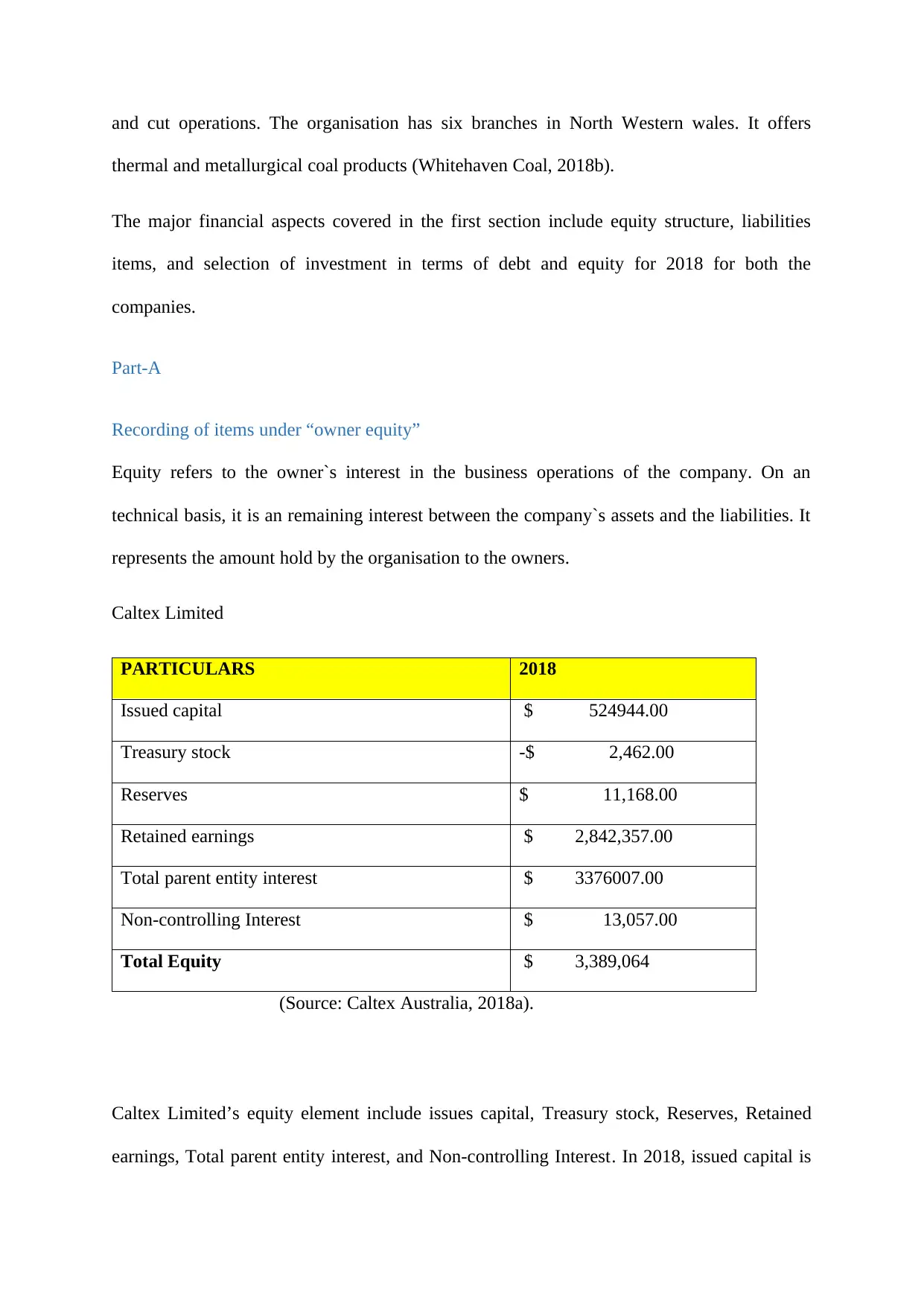
and cut operations. The organisation has six branches in North Western wales. It offers
thermal and metallurgical coal products (Whitehaven Coal, 2018b).
The major financial aspects covered in the first section include equity structure, liabilities
items, and selection of investment in terms of debt and equity for 2018 for both the
companies.
Part-A
Recording of items under “owner equity”
Equity refers to the owner`s interest in the business operations of the company. On an
technical basis, it is an remaining interest between the company`s assets and the liabilities. It
represents the amount hold by the organisation to the owners.
Caltex Limited
PARTICULARS 2018
Issued capital $ 524944.00
Treasury stock -$ 2,462.00
Reserves $ 11,168.00
Retained earnings $ 2,842,357.00
Total parent entity interest $ 3376007.00
Non-controlling Interest $ 13,057.00
Total Equity $ 3,389,064
(Source: Caltex Australia, 2018a).
Caltex Limited’s equity element include issues capital, Treasury stock, Reserves, Retained
earnings, Total parent entity interest, and Non-controlling Interest. In 2018, issued capital is
thermal and metallurgical coal products (Whitehaven Coal, 2018b).
The major financial aspects covered in the first section include equity structure, liabilities
items, and selection of investment in terms of debt and equity for 2018 for both the
companies.
Part-A
Recording of items under “owner equity”
Equity refers to the owner`s interest in the business operations of the company. On an
technical basis, it is an remaining interest between the company`s assets and the liabilities. It
represents the amount hold by the organisation to the owners.
Caltex Limited
PARTICULARS 2018
Issued capital $ 524944.00
Treasury stock -$ 2,462.00
Reserves $ 11,168.00
Retained earnings $ 2,842,357.00
Total parent entity interest $ 3376007.00
Non-controlling Interest $ 13,057.00
Total Equity $ 3,389,064
(Source: Caltex Australia, 2018a).
Caltex Limited’s equity element include issues capital, Treasury stock, Reserves, Retained
earnings, Total parent entity interest, and Non-controlling Interest. In 2018, issued capital is
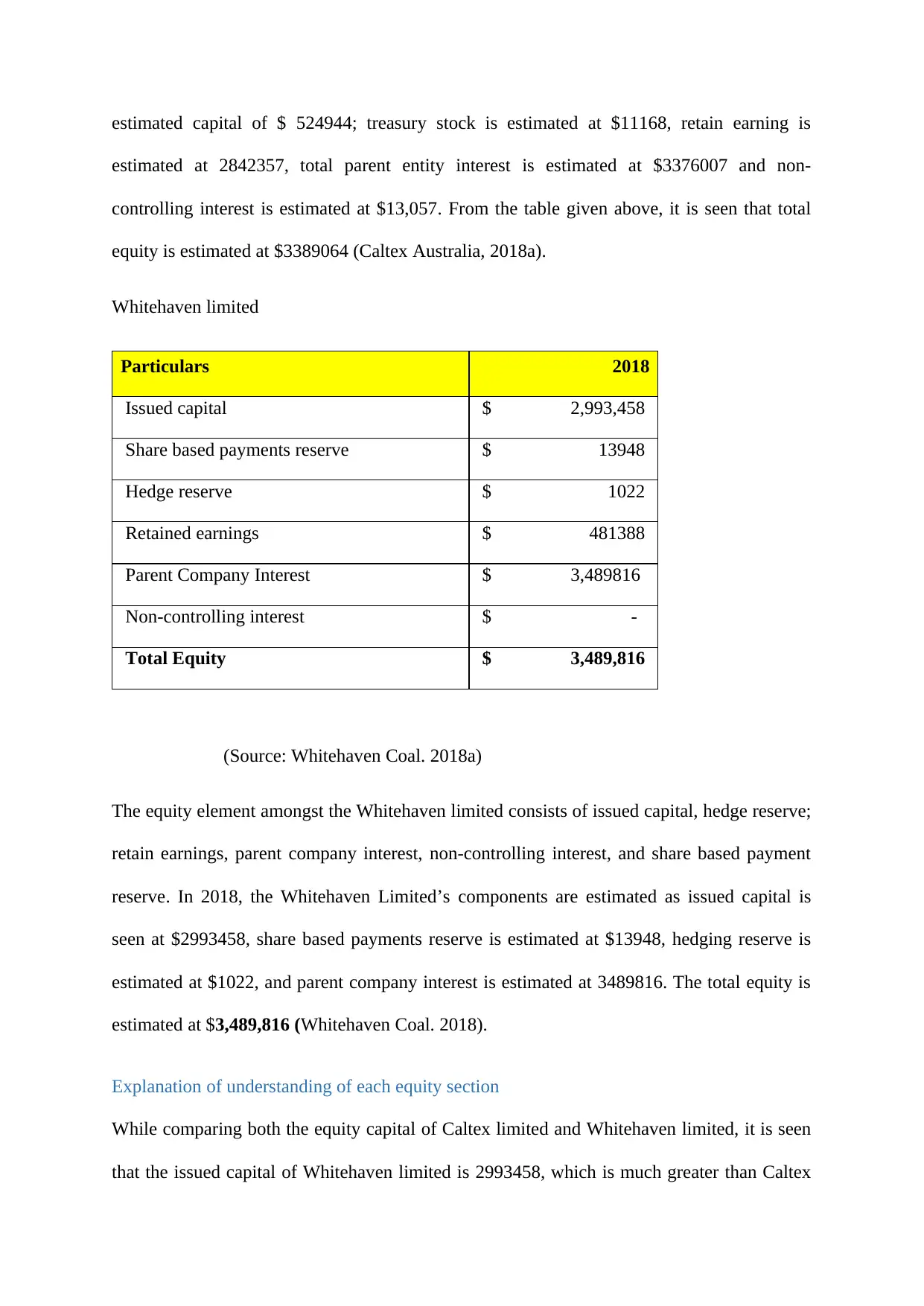
estimated capital of $ 524944; treasury stock is estimated at $11168, retain earning is
estimated at 2842357, total parent entity interest is estimated at $3376007 and non-
controlling interest is estimated at $13,057. From the table given above, it is seen that total
equity is estimated at $3389064 (Caltex Australia, 2018a).
Whitehaven limited
Particulars 2018
Issued capital $ 2,993,458
Share based payments reserve $ 13948
Hedge reserve $ 1022
Retained earnings $ 481388
Parent Company Interest $ 3,489816
Non-controlling interest $ -
Total Equity $ 3,489,816
(Source: Whitehaven Coal. 2018a)
The equity element amongst the Whitehaven limited consists of issued capital, hedge reserve;
retain earnings, parent company interest, non-controlling interest, and share based payment
reserve. In 2018, the Whitehaven Limited’s components are estimated as issued capital is
seen at $2993458, share based payments reserve is estimated at $13948, hedging reserve is
estimated at $1022, and parent company interest is estimated at 3489816. The total equity is
estimated at $3,489,816 (Whitehaven Coal. 2018).
Explanation of understanding of each equity section
While comparing both the equity capital of Caltex limited and Whitehaven limited, it is seen
that the issued capital of Whitehaven limited is 2993458, which is much greater than Caltex
estimated at 2842357, total parent entity interest is estimated at $3376007 and non-
controlling interest is estimated at $13,057. From the table given above, it is seen that total
equity is estimated at $3389064 (Caltex Australia, 2018a).
Whitehaven limited
Particulars 2018
Issued capital $ 2,993,458
Share based payments reserve $ 13948
Hedge reserve $ 1022
Retained earnings $ 481388
Parent Company Interest $ 3,489816
Non-controlling interest $ -
Total Equity $ 3,489,816
(Source: Whitehaven Coal. 2018a)
The equity element amongst the Whitehaven limited consists of issued capital, hedge reserve;
retain earnings, parent company interest, non-controlling interest, and share based payment
reserve. In 2018, the Whitehaven Limited’s components are estimated as issued capital is
seen at $2993458, share based payments reserve is estimated at $13948, hedging reserve is
estimated at $1022, and parent company interest is estimated at 3489816. The total equity is
estimated at $3,489,816 (Whitehaven Coal. 2018).
Explanation of understanding of each equity section
While comparing both the equity capital of Caltex limited and Whitehaven limited, it is seen
that the issued capital of Whitehaven limited is 2993458, which is much greater than Caltex
⊘ This is a preview!⊘
Do you want full access?
Subscribe today to unlock all pages.

Trusted by 1+ million students worldwide
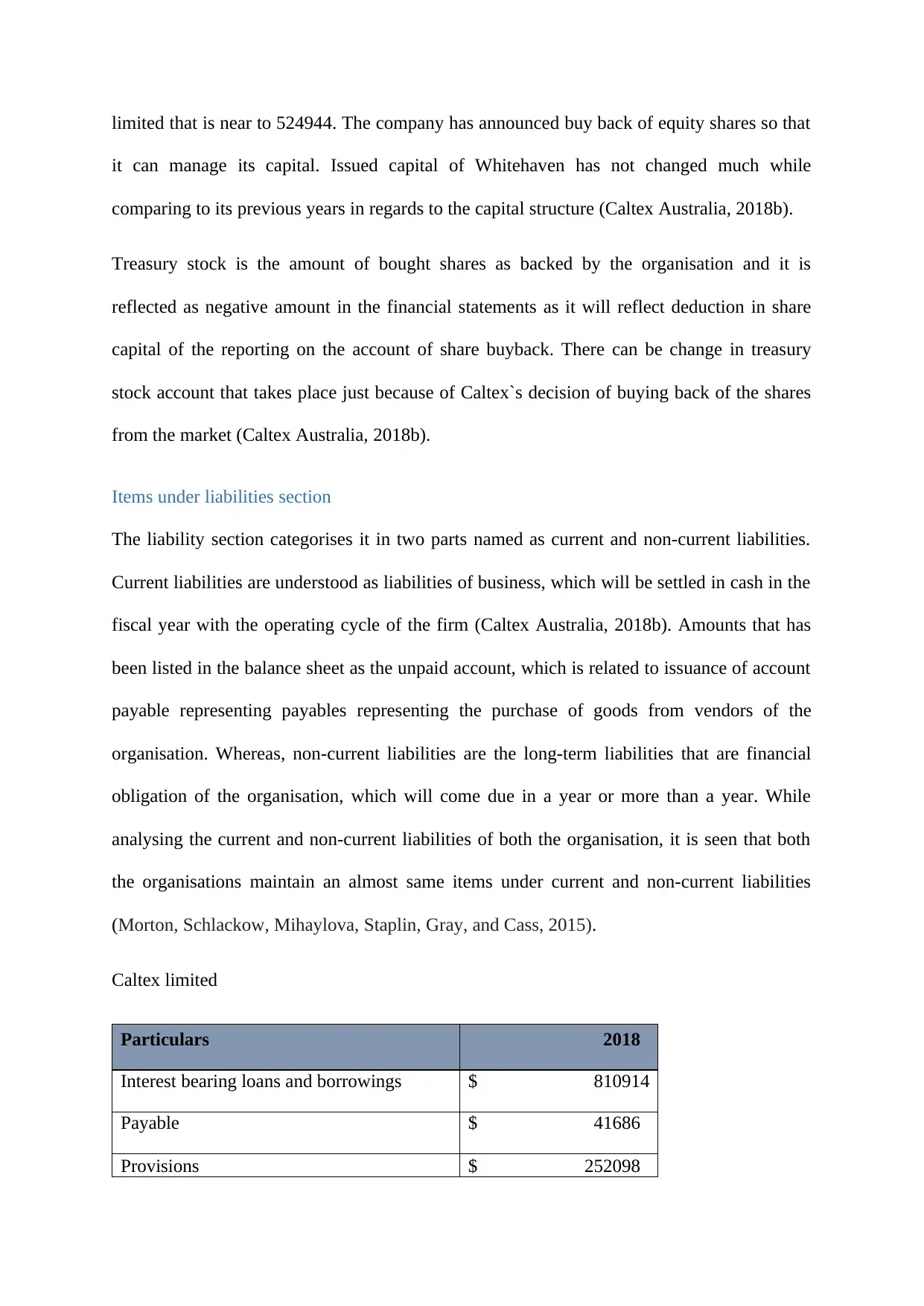
limited that is near to 524944. The company has announced buy back of equity shares so that
it can manage its capital. Issued capital of Whitehaven has not changed much while
comparing to its previous years in regards to the capital structure (Caltex Australia, 2018b).
Treasury stock is the amount of bought shares as backed by the organisation and it is
reflected as negative amount in the financial statements as it will reflect deduction in share
capital of the reporting on the account of share buyback. There can be change in treasury
stock account that takes place just because of Caltex`s decision of buying back of the shares
from the market (Caltex Australia, 2018b).
Items under liabilities section
The liability section categorises it in two parts named as current and non-current liabilities.
Current liabilities are understood as liabilities of business, which will be settled in cash in the
fiscal year with the operating cycle of the firm (Caltex Australia, 2018b). Amounts that has
been listed in the balance sheet as the unpaid account, which is related to issuance of account
payable representing payables representing the purchase of goods from vendors of the
organisation. Whereas, non-current liabilities are the long-term liabilities that are financial
obligation of the organisation, which will come due in a year or more than a year. While
analysing the current and non-current liabilities of both the organisation, it is seen that both
the organisations maintain an almost same items under current and non-current liabilities
(Morton, Schlackow, Mihaylova, Staplin, Gray, and Cass, 2015).
Caltex limited
Particulars 2018
Interest bearing loans and borrowings $ 810914
Payable $ 41686
Provisions $ 252098
it can manage its capital. Issued capital of Whitehaven has not changed much while
comparing to its previous years in regards to the capital structure (Caltex Australia, 2018b).
Treasury stock is the amount of bought shares as backed by the organisation and it is
reflected as negative amount in the financial statements as it will reflect deduction in share
capital of the reporting on the account of share buyback. There can be change in treasury
stock account that takes place just because of Caltex`s decision of buying back of the shares
from the market (Caltex Australia, 2018b).
Items under liabilities section
The liability section categorises it in two parts named as current and non-current liabilities.
Current liabilities are understood as liabilities of business, which will be settled in cash in the
fiscal year with the operating cycle of the firm (Caltex Australia, 2018b). Amounts that has
been listed in the balance sheet as the unpaid account, which is related to issuance of account
payable representing payables representing the purchase of goods from vendors of the
organisation. Whereas, non-current liabilities are the long-term liabilities that are financial
obligation of the organisation, which will come due in a year or more than a year. While
analysing the current and non-current liabilities of both the organisation, it is seen that both
the organisations maintain an almost same items under current and non-current liabilities
(Morton, Schlackow, Mihaylova, Staplin, Gray, and Cass, 2015).
Caltex limited
Particulars 2018
Interest bearing loans and borrowings $ 810914
Payable $ 41686
Provisions $ 252098
Paraphrase This Document
Need a fresh take? Get an instant paraphrase of this document with our AI Paraphraser
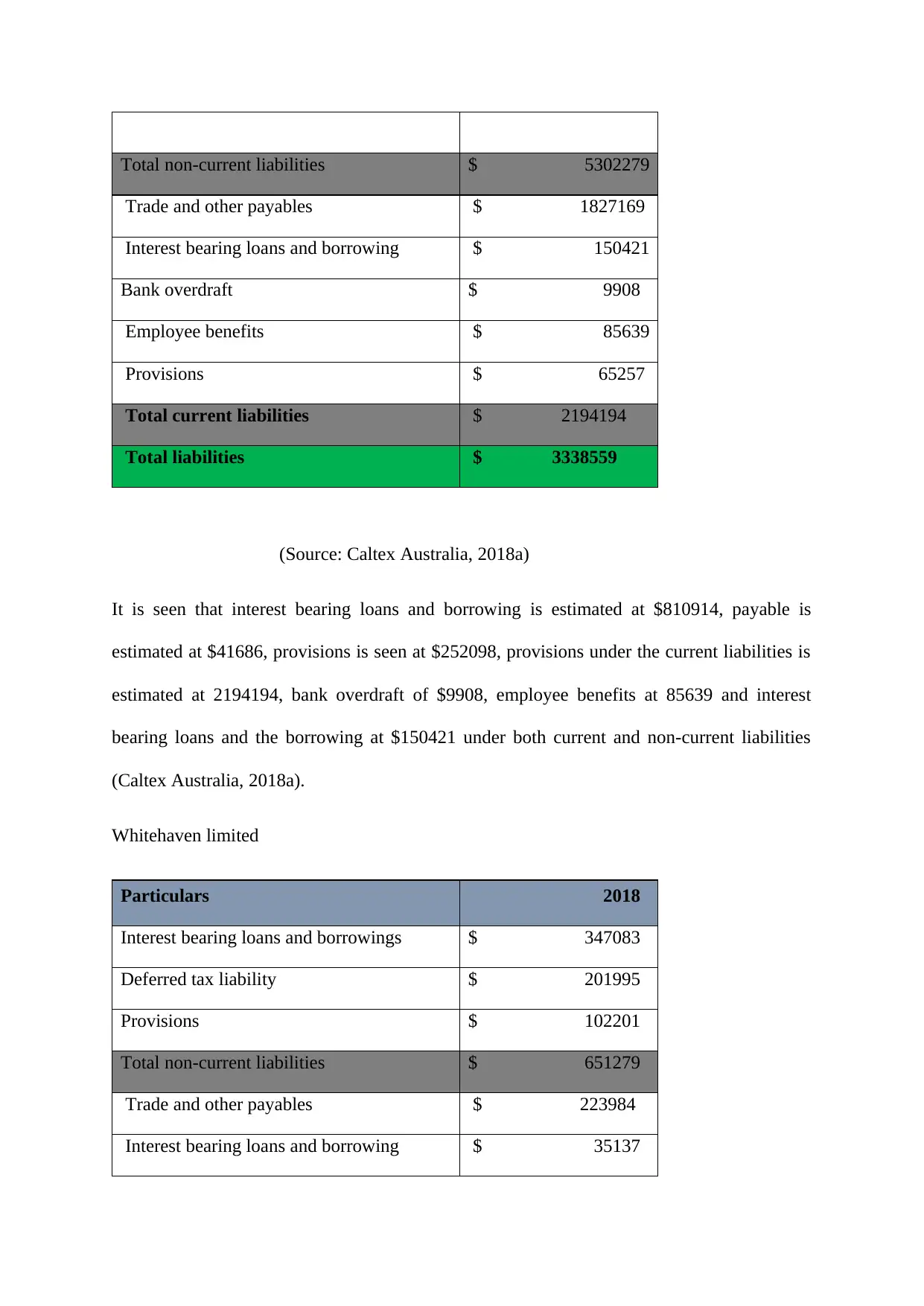
Total non-current liabilities $ 5302279
Trade and other payables $ 1827169
Interest bearing loans and borrowing $ 150421
Bank overdraft $ 9908
Employee benefits $ 85639
Provisions $ 65257
Total current liabilities $ 2194194
Total liabilities $ 3338559
(Source: Caltex Australia, 2018a)
It is seen that interest bearing loans and borrowing is estimated at $810914, payable is
estimated at $41686, provisions is seen at $252098, provisions under the current liabilities is
estimated at 2194194, bank overdraft of $9908, employee benefits at 85639 and interest
bearing loans and the borrowing at $150421 under both current and non-current liabilities
(Caltex Australia, 2018a).
Whitehaven limited
Particulars 2018
Interest bearing loans and borrowings $ 347083
Deferred tax liability $ 201995
Provisions $ 102201
Total non-current liabilities $ 651279
Trade and other payables $ 223984
Interest bearing loans and borrowing $ 35137
Trade and other payables $ 1827169
Interest bearing loans and borrowing $ 150421
Bank overdraft $ 9908
Employee benefits $ 85639
Provisions $ 65257
Total current liabilities $ 2194194
Total liabilities $ 3338559
(Source: Caltex Australia, 2018a)
It is seen that interest bearing loans and borrowing is estimated at $810914, payable is
estimated at $41686, provisions is seen at $252098, provisions under the current liabilities is
estimated at 2194194, bank overdraft of $9908, employee benefits at 85639 and interest
bearing loans and the borrowing at $150421 under both current and non-current liabilities
(Caltex Australia, 2018a).
Whitehaven limited
Particulars 2018
Interest bearing loans and borrowings $ 347083
Deferred tax liability $ 201995
Provisions $ 102201
Total non-current liabilities $ 651279
Trade and other payables $ 223984
Interest bearing loans and borrowing $ 35137
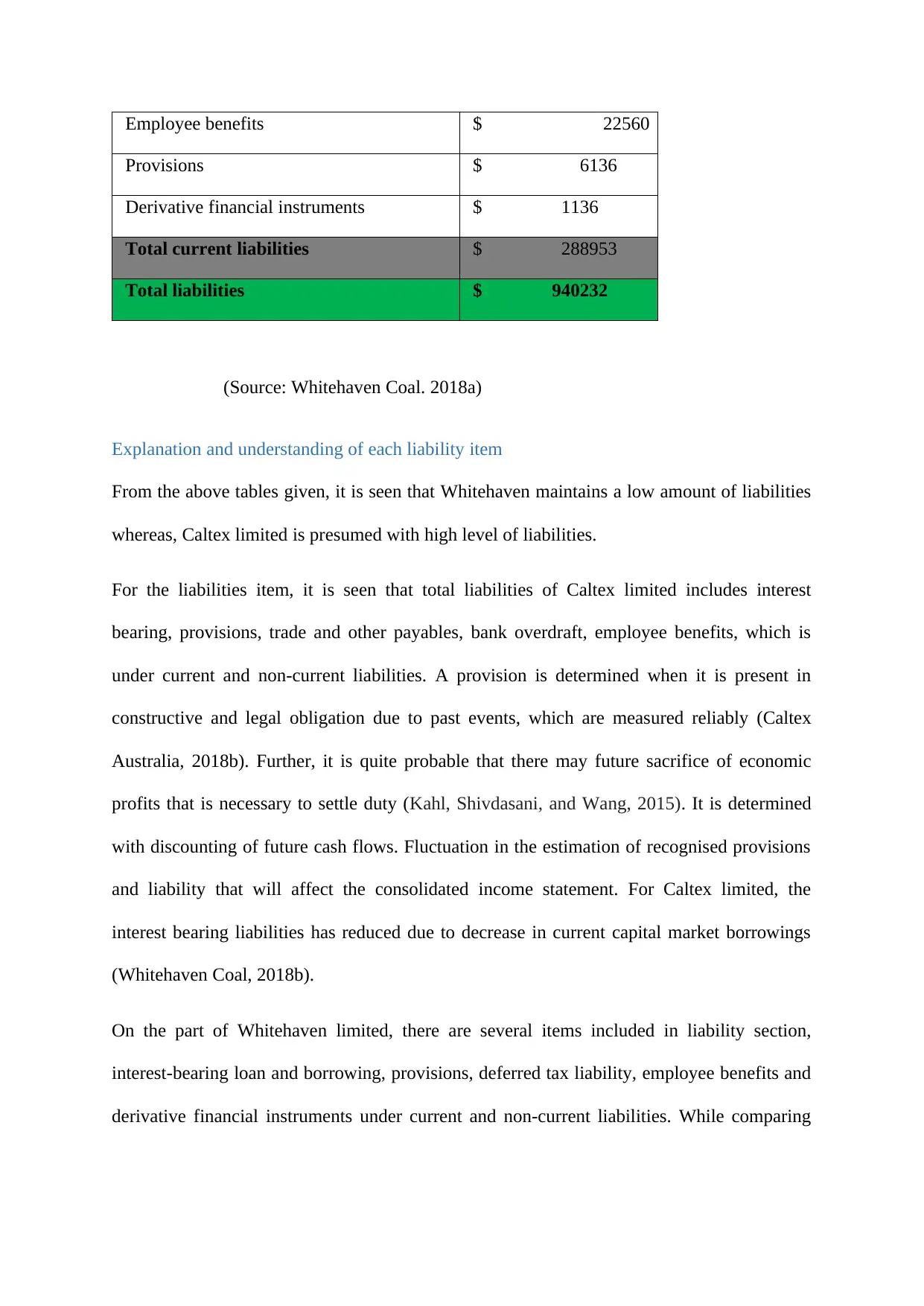
Employee benefits $ 22560
Provisions $ 6136
Derivative financial instruments $ 1136
Total current liabilities $ 288953
Total liabilities $ 940232
(Source: Whitehaven Coal. 2018a)
Explanation and understanding of each liability item
From the above tables given, it is seen that Whitehaven maintains a low amount of liabilities
whereas, Caltex limited is presumed with high level of liabilities.
For the liabilities item, it is seen that total liabilities of Caltex limited includes interest
bearing, provisions, trade and other payables, bank overdraft, employee benefits, which is
under current and non-current liabilities. A provision is determined when it is present in
constructive and legal obligation due to past events, which are measured reliably (Caltex
Australia, 2018b). Further, it is quite probable that there may future sacrifice of economic
profits that is necessary to settle duty (Kahl, Shivdasani, and Wang, 2015). It is determined
with discounting of future cash flows. Fluctuation in the estimation of recognised provisions
and liability that will affect the consolidated income statement. For Caltex limited, the
interest bearing liabilities has reduced due to decrease in current capital market borrowings
(Whitehaven Coal, 2018b).
On the part of Whitehaven limited, there are several items included in liability section,
interest-bearing loan and borrowing, provisions, deferred tax liability, employee benefits and
derivative financial instruments under current and non-current liabilities. While comparing
Provisions $ 6136
Derivative financial instruments $ 1136
Total current liabilities $ 288953
Total liabilities $ 940232
(Source: Whitehaven Coal. 2018a)
Explanation and understanding of each liability item
From the above tables given, it is seen that Whitehaven maintains a low amount of liabilities
whereas, Caltex limited is presumed with high level of liabilities.
For the liabilities item, it is seen that total liabilities of Caltex limited includes interest
bearing, provisions, trade and other payables, bank overdraft, employee benefits, which is
under current and non-current liabilities. A provision is determined when it is present in
constructive and legal obligation due to past events, which are measured reliably (Caltex
Australia, 2018b). Further, it is quite probable that there may future sacrifice of economic
profits that is necessary to settle duty (Kahl, Shivdasani, and Wang, 2015). It is determined
with discounting of future cash flows. Fluctuation in the estimation of recognised provisions
and liability that will affect the consolidated income statement. For Caltex limited, the
interest bearing liabilities has reduced due to decrease in current capital market borrowings
(Whitehaven Coal, 2018b).
On the part of Whitehaven limited, there are several items included in liability section,
interest-bearing loan and borrowing, provisions, deferred tax liability, employee benefits and
derivative financial instruments under current and non-current liabilities. While comparing
⊘ This is a preview!⊘
Do you want full access?
Subscribe today to unlock all pages.

Trusted by 1+ million students worldwide
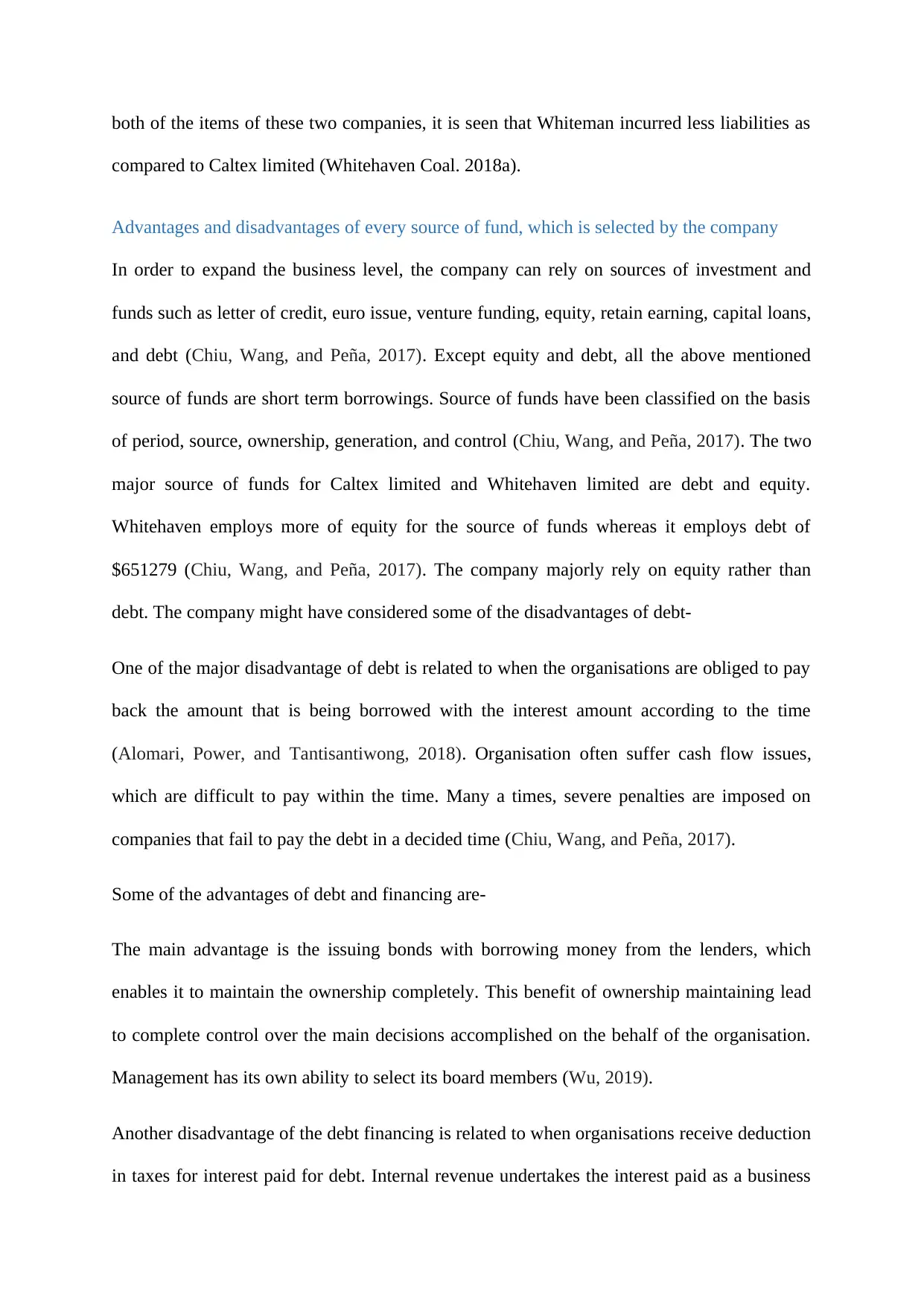
both of the items of these two companies, it is seen that Whiteman incurred less liabilities as
compared to Caltex limited (Whitehaven Coal. 2018a).
Advantages and disadvantages of every source of fund, which is selected by the company
In order to expand the business level, the company can rely on sources of investment and
funds such as letter of credit, euro issue, venture funding, equity, retain earning, capital loans,
and debt (Chiu, Wang, and Peña, 2017). Except equity and debt, all the above mentioned
source of funds are short term borrowings. Source of funds have been classified on the basis
of period, source, ownership, generation, and control (Chiu, Wang, and Peña, 2017). The two
major source of funds for Caltex limited and Whitehaven limited are debt and equity.
Whitehaven employs more of equity for the source of funds whereas it employs debt of
$651279 (Chiu, Wang, and Peña, 2017). The company majorly rely on equity rather than
debt. The company might have considered some of the disadvantages of debt-
One of the major disadvantage of debt is related to when the organisations are obliged to pay
back the amount that is being borrowed with the interest amount according to the time
(Alomari, Power, and Tantisantiwong, 2018). Organisation often suffer cash flow issues,
which are difficult to pay within the time. Many a times, severe penalties are imposed on
companies that fail to pay the debt in a decided time (Chiu, Wang, and Peña, 2017).
Some of the advantages of debt and financing are-
The main advantage is the issuing bonds with borrowing money from the lenders, which
enables it to maintain the ownership completely. This benefit of ownership maintaining lead
to complete control over the main decisions accomplished on the behalf of the organisation.
Management has its own ability to select its board members (Wu, 2019).
Another disadvantage of the debt financing is related to when organisations receive deduction
in taxes for interest paid for debt. Internal revenue undertakes the interest paid as a business
compared to Caltex limited (Whitehaven Coal. 2018a).
Advantages and disadvantages of every source of fund, which is selected by the company
In order to expand the business level, the company can rely on sources of investment and
funds such as letter of credit, euro issue, venture funding, equity, retain earning, capital loans,
and debt (Chiu, Wang, and Peña, 2017). Except equity and debt, all the above mentioned
source of funds are short term borrowings. Source of funds have been classified on the basis
of period, source, ownership, generation, and control (Chiu, Wang, and Peña, 2017). The two
major source of funds for Caltex limited and Whitehaven limited are debt and equity.
Whitehaven employs more of equity for the source of funds whereas it employs debt of
$651279 (Chiu, Wang, and Peña, 2017). The company majorly rely on equity rather than
debt. The company might have considered some of the disadvantages of debt-
One of the major disadvantage of debt is related to when the organisations are obliged to pay
back the amount that is being borrowed with the interest amount according to the time
(Alomari, Power, and Tantisantiwong, 2018). Organisation often suffer cash flow issues,
which are difficult to pay within the time. Many a times, severe penalties are imposed on
companies that fail to pay the debt in a decided time (Chiu, Wang, and Peña, 2017).
Some of the advantages of debt and financing are-
The main advantage is the issuing bonds with borrowing money from the lenders, which
enables it to maintain the ownership completely. This benefit of ownership maintaining lead
to complete control over the main decisions accomplished on the behalf of the organisation.
Management has its own ability to select its board members (Wu, 2019).
Another disadvantage of the debt financing is related to when organisations receive deduction
in taxes for interest paid for debt. Internal revenue undertakes the interest paid as a business
Paraphrase This Document
Need a fresh take? Get an instant paraphrase of this document with our AI Paraphraser
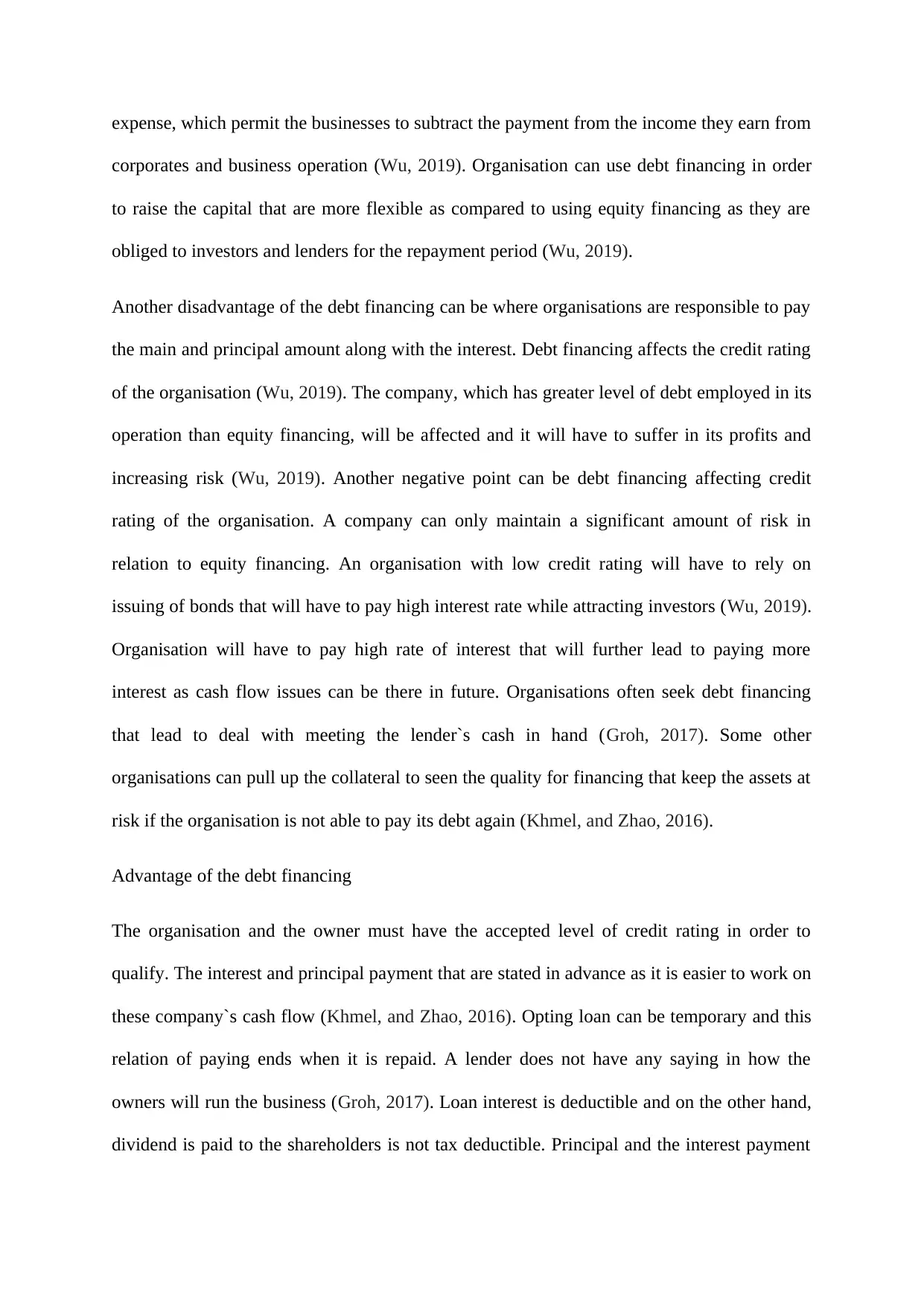
expense, which permit the businesses to subtract the payment from the income they earn from
corporates and business operation (Wu, 2019). Organisation can use debt financing in order
to raise the capital that are more flexible as compared to using equity financing as they are
obliged to investors and lenders for the repayment period (Wu, 2019).
Another disadvantage of the debt financing can be where organisations are responsible to pay
the main and principal amount along with the interest. Debt financing affects the credit rating
of the organisation (Wu, 2019). The company, which has greater level of debt employed in its
operation than equity financing, will be affected and it will have to suffer in its profits and
increasing risk (Wu, 2019). Another negative point can be debt financing affecting credit
rating of the organisation. A company can only maintain a significant amount of risk in
relation to equity financing. An organisation with low credit rating will have to rely on
issuing of bonds that will have to pay high interest rate while attracting investors (Wu, 2019).
Organisation will have to pay high rate of interest that will further lead to paying more
interest as cash flow issues can be there in future. Organisations often seek debt financing
that lead to deal with meeting the lender`s cash in hand (Groh, 2017). Some other
organisations can pull up the collateral to seen the quality for financing that keep the assets at
risk if the organisation is not able to pay its debt again (Khmel, and Zhao, 2016).
Advantage of the debt financing
The organisation and the owner must have the accepted level of credit rating in order to
qualify. The interest and principal payment that are stated in advance as it is easier to work on
these company`s cash flow (Khmel, and Zhao, 2016). Opting loan can be temporary and this
relation of paying ends when it is repaid. A lender does not have any saying in how the
owners will run the business (Groh, 2017). Loan interest is deductible and on the other hand,
dividend is paid to the shareholders is not tax deductible. Principal and the interest payment
corporates and business operation (Wu, 2019). Organisation can use debt financing in order
to raise the capital that are more flexible as compared to using equity financing as they are
obliged to investors and lenders for the repayment period (Wu, 2019).
Another disadvantage of the debt financing can be where organisations are responsible to pay
the main and principal amount along with the interest. Debt financing affects the credit rating
of the organisation (Wu, 2019). The company, which has greater level of debt employed in its
operation than equity financing, will be affected and it will have to suffer in its profits and
increasing risk (Wu, 2019). Another negative point can be debt financing affecting credit
rating of the organisation. A company can only maintain a significant amount of risk in
relation to equity financing. An organisation with low credit rating will have to rely on
issuing of bonds that will have to pay high interest rate while attracting investors (Wu, 2019).
Organisation will have to pay high rate of interest that will further lead to paying more
interest as cash flow issues can be there in future. Organisations often seek debt financing
that lead to deal with meeting the lender`s cash in hand (Groh, 2017). Some other
organisations can pull up the collateral to seen the quality for financing that keep the assets at
risk if the organisation is not able to pay its debt again (Khmel, and Zhao, 2016).
Advantage of the debt financing
The organisation and the owner must have the accepted level of credit rating in order to
qualify. The interest and principal payment that are stated in advance as it is easier to work on
these company`s cash flow (Khmel, and Zhao, 2016). Opting loan can be temporary and this
relation of paying ends when it is repaid. A lender does not have any saying in how the
owners will run the business (Groh, 2017). Loan interest is deductible and on the other hand,
dividend is paid to the shareholders is not tax deductible. Principal and the interest payment
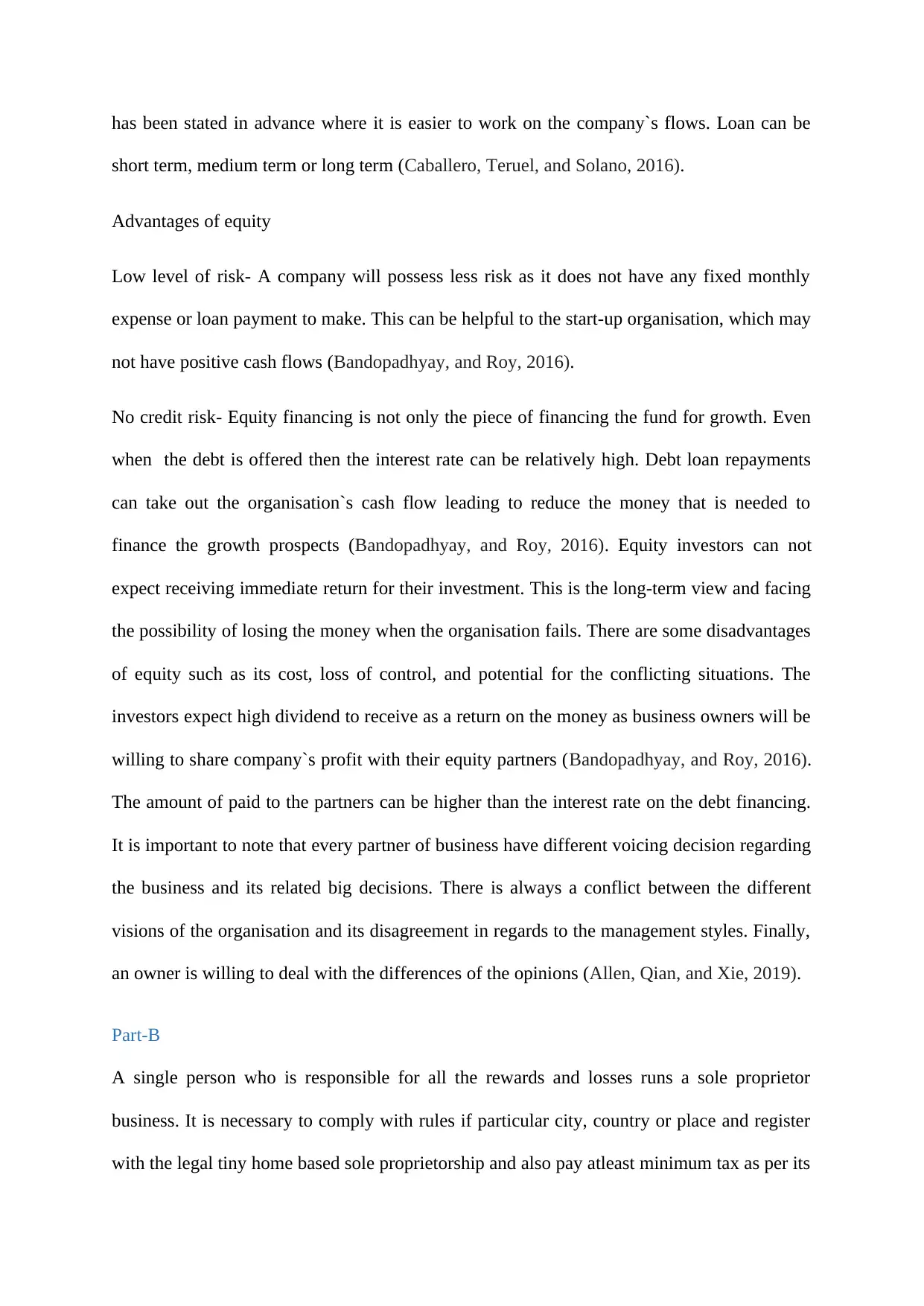
has been stated in advance where it is easier to work on the company`s flows. Loan can be
short term, medium term or long term (Caballero, Teruel, and Solano, 2016).
Advantages of equity
Low level of risk- A company will possess less risk as it does not have any fixed monthly
expense or loan payment to make. This can be helpful to the start-up organisation, which may
not have positive cash flows (Bandopadhyay, and Roy, 2016).
No credit risk- Equity financing is not only the piece of financing the fund for growth. Even
when the debt is offered then the interest rate can be relatively high. Debt loan repayments
can take out the organisation`s cash flow leading to reduce the money that is needed to
finance the growth prospects (Bandopadhyay, and Roy, 2016). Equity investors can not
expect receiving immediate return for their investment. This is the long-term view and facing
the possibility of losing the money when the organisation fails. There are some disadvantages
of equity such as its cost, loss of control, and potential for the conflicting situations. The
investors expect high dividend to receive as a return on the money as business owners will be
willing to share company`s profit with their equity partners (Bandopadhyay, and Roy, 2016).
The amount of paid to the partners can be higher than the interest rate on the debt financing.
It is important to note that every partner of business have different voicing decision regarding
the business and its related big decisions. There is always a conflict between the different
visions of the organisation and its disagreement in regards to the management styles. Finally,
an owner is willing to deal with the differences of the opinions (Allen, Qian, and Xie, 2019).
Part-B
A single person who is responsible for all the rewards and losses runs a sole proprietor
business. It is necessary to comply with rules if particular city, country or place and register
with the legal tiny home based sole proprietorship and also pay atleast minimum tax as per its
short term, medium term or long term (Caballero, Teruel, and Solano, 2016).
Advantages of equity
Low level of risk- A company will possess less risk as it does not have any fixed monthly
expense or loan payment to make. This can be helpful to the start-up organisation, which may
not have positive cash flows (Bandopadhyay, and Roy, 2016).
No credit risk- Equity financing is not only the piece of financing the fund for growth. Even
when the debt is offered then the interest rate can be relatively high. Debt loan repayments
can take out the organisation`s cash flow leading to reduce the money that is needed to
finance the growth prospects (Bandopadhyay, and Roy, 2016). Equity investors can not
expect receiving immediate return for their investment. This is the long-term view and facing
the possibility of losing the money when the organisation fails. There are some disadvantages
of equity such as its cost, loss of control, and potential for the conflicting situations. The
investors expect high dividend to receive as a return on the money as business owners will be
willing to share company`s profit with their equity partners (Bandopadhyay, and Roy, 2016).
The amount of paid to the partners can be higher than the interest rate on the debt financing.
It is important to note that every partner of business have different voicing decision regarding
the business and its related big decisions. There is always a conflict between the different
visions of the organisation and its disagreement in regards to the management styles. Finally,
an owner is willing to deal with the differences of the opinions (Allen, Qian, and Xie, 2019).
Part-B
A single person who is responsible for all the rewards and losses runs a sole proprietor
business. It is necessary to comply with rules if particular city, country or place and register
with the legal tiny home based sole proprietorship and also pay atleast minimum tax as per its
⊘ This is a preview!⊘
Do you want full access?
Subscribe today to unlock all pages.

Trusted by 1+ million students worldwide
1 out of 15
Related Documents
Your All-in-One AI-Powered Toolkit for Academic Success.
+13062052269
info@desklib.com
Available 24*7 on WhatsApp / Email
![[object Object]](/_next/static/media/star-bottom.7253800d.svg)
Unlock your academic potential
Copyright © 2020–2025 A2Z Services. All Rights Reserved. Developed and managed by ZUCOL.





